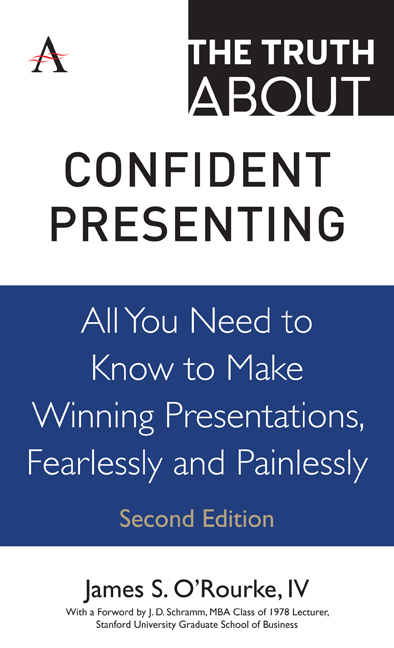 The Truth about Confident Presenting
The Truth about Confident Presenting Book contents
- Frontmatter
- Contents
- Foreword
- Introduction
- Part I Some Initial Truths
- Part II The Truth About Getting Ready to Speak
- Part III The Truth About What Makes People Listen
- Part IV The Truth About Developing Support for Your Presentation
- Part V The Truth About Getting Up to Speak
- Part VI The Truth About Managing Anxiety
- Truth 32 All speakers get nervous
- Truth 33 Recognize anxiety before it begins
- Truth 34 Deal with nervous behaviors
- Truth 35 Keep your nervousness to yourself
- Part VII The Truth About Nonverbal Communication
- Part VIII The Truth About Visual Aids
- Part IX The Truth About Handling an Audience
- Part X The Truth About What Makes a Presentation Work
- References
- Acknowledgments
- About the Author
Truth 33 - Recognize anxiety before it begins
from Part VI - The Truth About Managing Anxiety
- Frontmatter
- Contents
- Foreword
- Introduction
- Part I Some Initial Truths
- Part II The Truth About Getting Ready to Speak
- Part III The Truth About What Makes People Listen
- Part IV The Truth About Developing Support for Your Presentation
- Part V The Truth About Getting Up to Speak
- Part VI The Truth About Managing Anxiety
- Truth 32 All speakers get nervous
- Truth 33 Recognize anxiety before it begins
- Truth 34 Deal with nervous behaviors
- Truth 35 Keep your nervousness to yourself
- Part VII The Truth About Nonverbal Communication
- Part VIII The Truth About Visual Aids
- Part IX The Truth About Handling an Audience
- Part X The Truth About What Makes a Presentation Work
- References
- Acknowledgments
- About the Author
Summary
The best way to deal with anxiety in a presentation is to recognize it before it begins. The audience won't know you're nervous unless you tell them you are (my advice: don't), or they see and hear nervousness once you begin speaking. If you deal with your nerves in advance of that, your chances for a successful presentation are much greater.
Behavioral psychologists commonly recommend three ways to diminish the negative effects of anxiety. These include depersonalization, behavior modification and practice.
Depersonalization. This technique requires that you think of your speech in terms that aren't personal to you. Some degree of anxiety flows out of personal concerns: “Will the audience understand my argument?” “What if I offend somebody?” “Do I look all right?” These are natural concerns, but they can debilitate a speaker who focuses on herself and not the content of the speech. The audience is much more interested in the subject of your talk than they are in you as a person. Once you become a celebrity, of course, that may change, but for now, they're focused on content. So should you.
Behavior modification. Trying to completely relax during a speech is both understandable and impossible. Audiences expect a speaker to be intense about the subject matter, but intensity is not the same thing as anxiety, and you should focus all of your energy on suppressing your nerves.
Some of the more common symptoms of a nervous speaker are trembling, fidgeting, a weak or quivering voice and losing your concentration— all of which are correctable. These symptoms are usually most acute at the beginning of a speech 33 and generally dissipate as a speaker moves into the heart of the argument. In fact, by the end of most speeches, there are usually no outward signs of anxiety for even the most nervous speakers.
So, if you're feeling anxious as a presentation begins, make certain that you've done all you can in advance to make this a comfortable moment. Your first priority is to breathe properly. Nervousness can cause you to take shallow, quick breaths that often translate into a reedy, panicked voice. Before you step up to the podium, consciously take a couple of long, deep breaths. Not only will such breathing patterns contribute to a stronger voice, but they will also help you to relax.
- Type
- Chapter
- Information
- The Truth about Confident PresentingAll You Need To Know To Make Winning Presentations, Fearlessly And Painlessly, pp. 131 - 134Publisher: Anthem PressPrint publication year: 2019
